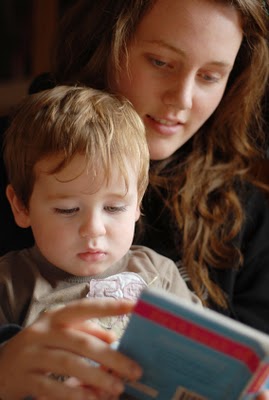Today’s guest post is from a “virtual friend” of mine, Rivka. Don’t you just love that name? : ) Rivka Kawano is a mom of three blessings, all age three and under, who is always striving to find the best books for them to grow on. Her book review website, www.beautifulbooksforchildren.com, is a way for her to keep track of all those books and ideas and share them with other parents too. I think you’ll find her post to be a blessing!
Kids books are nothing special. A way to keep the little ones entertained, teach them their colors and numbers, and give mom and dad five minutes of quiet.
What if we started thinking of the books our children read as so much more than that. What if we realized that every image, every word, every concept, is developing their mind and helping to create the person they will become. What if we acknowledged that we are sending them messages, some overt and some very subtle, about how we feel about the world and each person’s place in it. I think we could start a revolution.
Think I am being overly dramatic? What kind of message do your children get if every book they own show only children of their own skin color – especially if those books are talking about things like God’s love? When you tell children that neatness counts, and we should always do our best, do you think they don’t notice that when a book is just a cut and paste commercialization throwing colors and numbers on a page? If listening is important, why is it so funny in a book when a child does not listen?
Our heavenly Father has given us parents such a gift and such a responsibility. The books that we chose for our children are a part of that too. We need to invest the time and effort that it takes to find good ones that are falling in line with the lessons we are trying to teach them. Even if it is just a book about colors or shapes.
Deciding to find great books is one thing. Finding them is quite another. It can be done! How do we decide which books are good and which aren’t? Ask yourself these questions:
- Is this book beautiful? Does it display the fundamental principles of quality workmanship in the way it is crafted?
- How will it make your child feel? What emotions does it display? Are these emotions that you want to encourage?
- What are the overt values of the book? According to the Bible, witchcraft is not good, does this book support that idea or contradict it? Do the themes of the book themselves undermine good spiritual principles?
- What are the underlying values of the book? Do the characters in the book show respect and love for each other? If not what are the consequences? What is “good” and what is “bad” in this book? Do the definitions of the book agree with the Word of God?
- What will your child learn from reading this book with you? Animals, numbers, letters, shapes, how to feel about a new sibling? Does this book present these things in the most engaging way possible? Does it make learning fun?
- How are other people presented in this book? Are any groups excluded, demeaned, or degraded either in the words, or in the way they are presented in the pictures?
- Does this book tell the truth? Not to mean that we should never enjoy fiction, but does it share the bigger capital ‘T’ Truth that God made the world, that He loves us, and does it fairly represent other ideas and people?
Always preview books before showing them to your children. Children are easily enticed by bright colors and fun-looking characters. It is so much harder to have to take a book away from a child, once they are excited about it, than it is to take the time to see what its contents are before the y even get the chance.
y even get the chance.
Always pay attention to what your child is telling you. My three year old has amazing discernment. Perhaps it is because he is less jaded, but often early on in a video program or book he will say “this is too scary for me,” or “this is for grown-ups.” When I have laughed it off as childhood silliness, I have regretted it. If your child is sending you the message that they don’t feel comfortable with a book, perhaps they are seeing something you are not – and you should listen.
It is important that we agree with God and His word in all things. If children are a blessing, then you should not be choosing books that display a new baby as a bad thing. If God made all the people of the world, then one group or another should not be regularly marginalized or made fun of. If hurting each other or being hurt is not part of God’s plan, then it should not be funny to read books, tell jokes, or see shows that laugh at other’s pain.
Finding great books can seem overwhelming at times. Schedule outings without kids to browse books at the bookstore or library. Ask trusted friends and family for recommendations. Or follow a book review website that shares your values.
When you take the time you will be rewarded in so many ways. Not only will you be filling your home with positive messages, but your children will learn to love and value literature, and how to view it critically. The books you do have will get plenty of use as they are enjoyed again and again.
Story books are important, most of the Bible is stories. Make sure the books building your children’s character are good ones.
“Finally, brothers and sisters, whatever is true, whatever is noble, whatever is right, whatever is pure, whatever is lovely, whatever is admirable—if anything is excellent or praiseworthy—think about such things.” Philipians 4:8 (NIV)

























Recent Comments